
An undergraduate research journal at James Madison University is not a novel concept.
The James Madison Undergraduate Research Journal (2013-present) builds on the work of 2007-2009 JMURJ student editors. In the mid-1990s, the Madison Journal of Undergraduate Research published four volumes of undergraduate research. And back when JMU was the State Normal School for Women at Harrisonburg (1914-24), the State Teachers College at Harrisonburg (1924-38), and Madison College (starting in 1938), an in-house publication titled The Virginia Teacher regularly published undergraduate reviews and articles.
Below, we highlight recent JMURJ efforts before offering snapshots from JMU's history of publishing undergraduate research and scholarship. You can help us fill in some of the many gaps: let us know about JMU's ongoing, recent, or past efforts to promote and publish undergraduate research and scholarship.
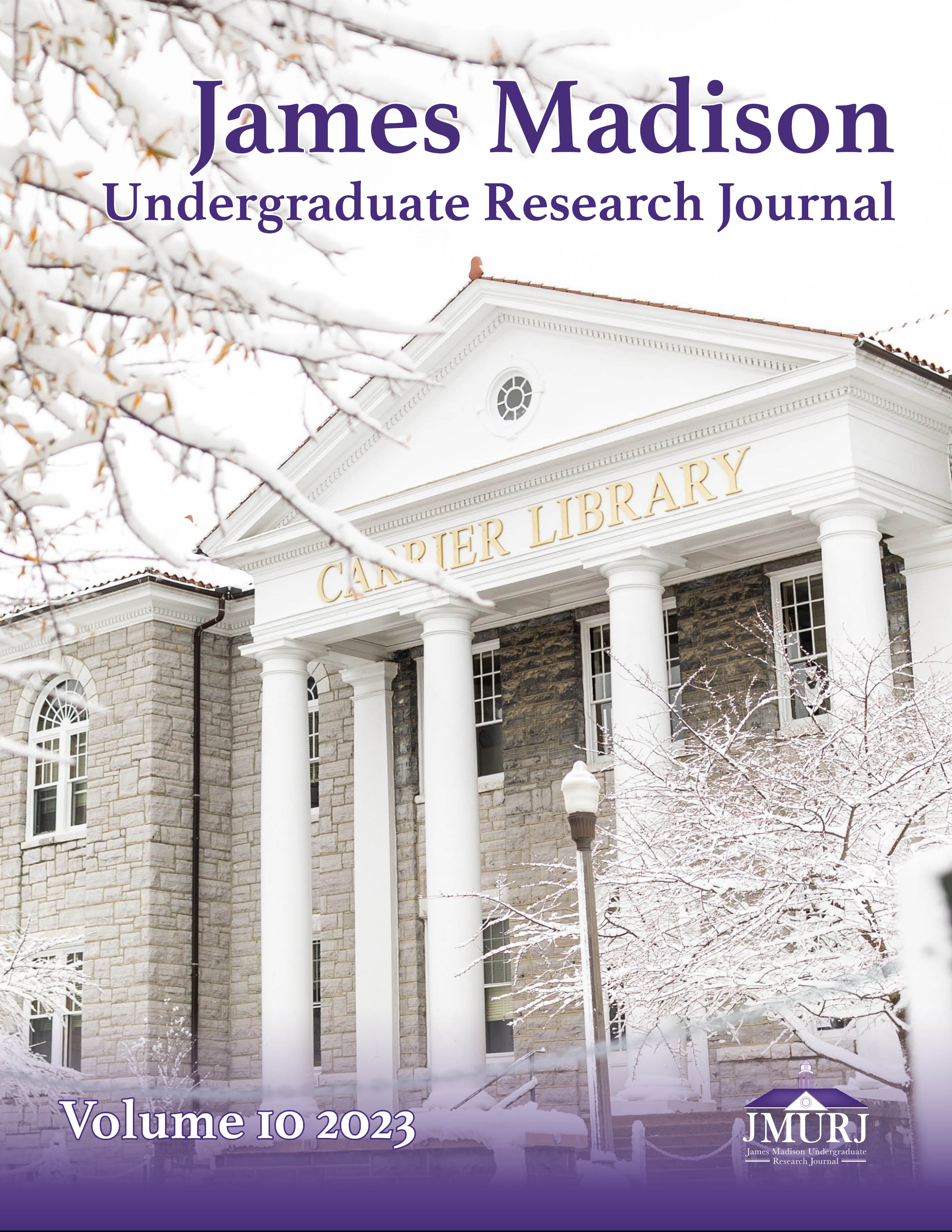
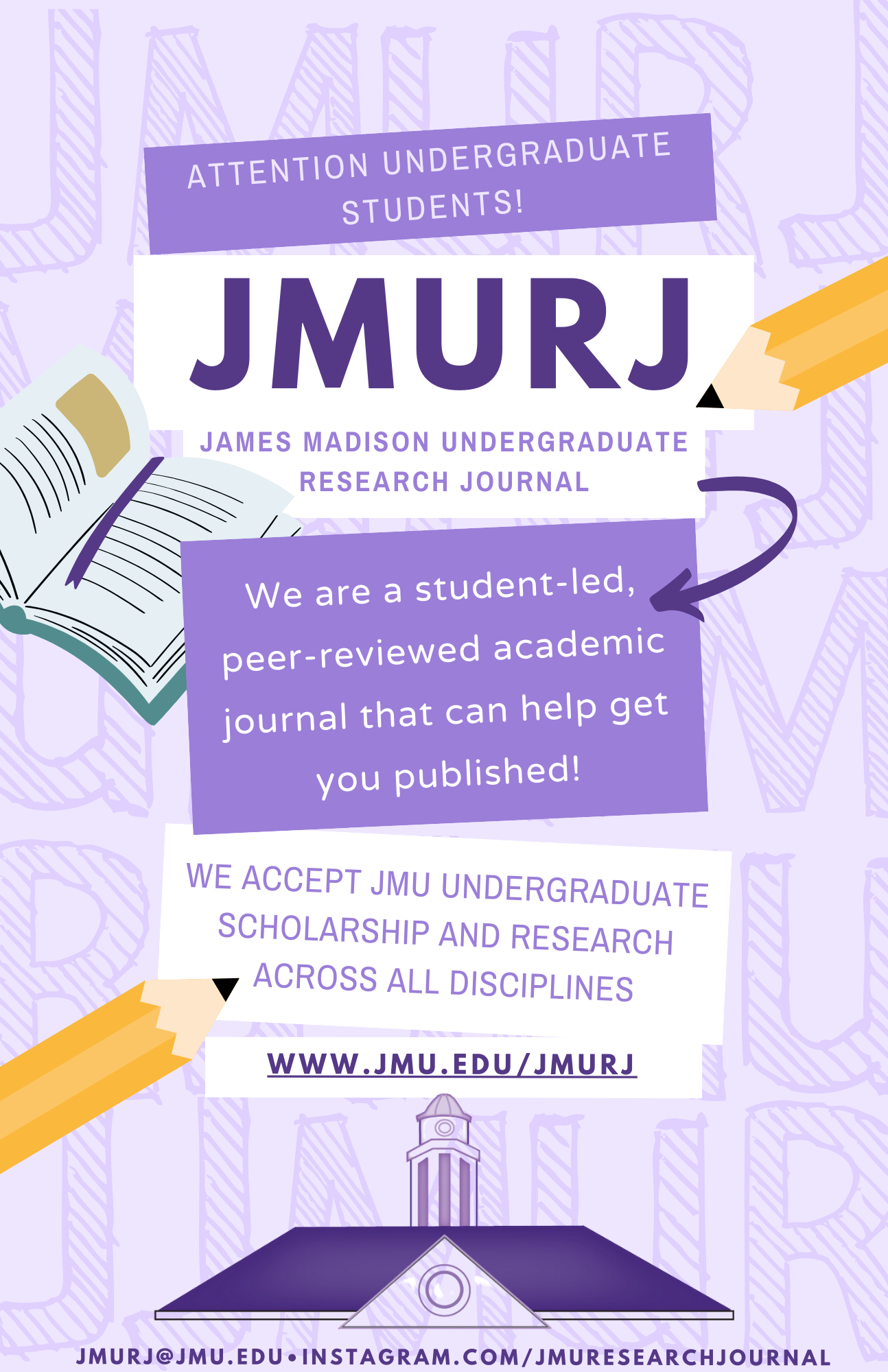
2022-2023
- JMURJ celebrates Volume 10!
- Volume 10 features research and scholarship from five JMU colleges: first pieces from Chemistry and Educational Foundations and Exceptionalities, strong submissions from English and Psychology, and bookending articles from Art History.
- JMURJ Managing Editors Lauren Howard (Fall 2022), Kate Peppiatt (Fall 2022/Spring 2023), LauraJean Logue (Spring 2023), Andrew Hess (Fall 2023), Rachel Tan (Fall 2023/Spring 2024), and Sarah Allen (Spring 2024) lead 31 JMURJ Editorial Board members with 12 different JMU majors and 13 different minors through more than three semesters of work.
- In February 2023, Provost Heather Coltman requests copies of JMURJ Volume 10 to share with JMU's Board of Visitors.
- JMURJ celebrates 10 volumes!
- JMURJ submissions have been dowloaded more than 230.000 times in 208 countries, territories, islands, federated states, and jurisdictions around the world.
- The 21 first-timers among JMURJ's 42 Volume 10 faculty reviewers mean that 271 JMU faculty members have contributed their time and expertise to the journal (and have at least one JMURJ "thank you" mug).
- In Spring 2013, nine sophomores and a freshman convened in a pre-renovation Wilson Hall closet to imagine a sustainable, inclusive, curricular undergraduate research journal. Since then, nearly 130 JMURJ Editorial Board members have worked to promote, publish, and share JMU undergraduate research and scholarship. In Spring 2023, JMURJ launches a LinkedIn page, and in Fall 2023, the journal begins a series of "Where Are They Now" posts on its Instagram and Facebook platforms.
- JMURJ continues its enduring partnership with JMU's Office of Research, Economic Development, and Innovation, affirming REDI's Office of Student Awards, Initiatives, and Research (STAIR) as a JMURJ sponsor.
2021-2022
- Volume 9 features first entries from Anthropology, Economics, and Social Work. The volume's six pieces come from five JMU colleges: Arts and Letters, Business, Health and Behavioral Studies, Visual and Performing Arts, and Science and Mathematics.
- Through nine volumes, JMURJ articles have been downloaded in 195 countries, according to the JMURJ Scholarly Commons publishing platform. There are +/-195 countries in the world.
- JMURJ hits 250! The volume's 17 first-time reviewers mean that 250 JMU faculty members have volunteered their time and disciplinary expertise over the years. All told, the volume's 39 faculty reviewers serve in 25 different academic departments.
- Managing Editor Tori Carpenter leads the JMURJ Editorial Board. The sole returning board member in Fall 2021, Carpenter coordinates the efforts of a new team of editors, creates the design for Volume 9 (starting with the volume cover), and develops resources for current and future board members.
- Fall 2022 co-Managing Editors Lauren Howard and Kate Peppiatt lead a strong team in completing the volume. Lead Editor Sophie Edlich joins Howard in seeing the volume through from start to finish.
- Through three semesters, 30 JMURJ Editorial Board members majoring in 11 different disciplines and minoring in 11 different disciplines contribute to Volume 9.
- In December 2022, Provost Heather Coltman requests copies of JMURJ Volume 9 to share with JMU's Board of Visitors.
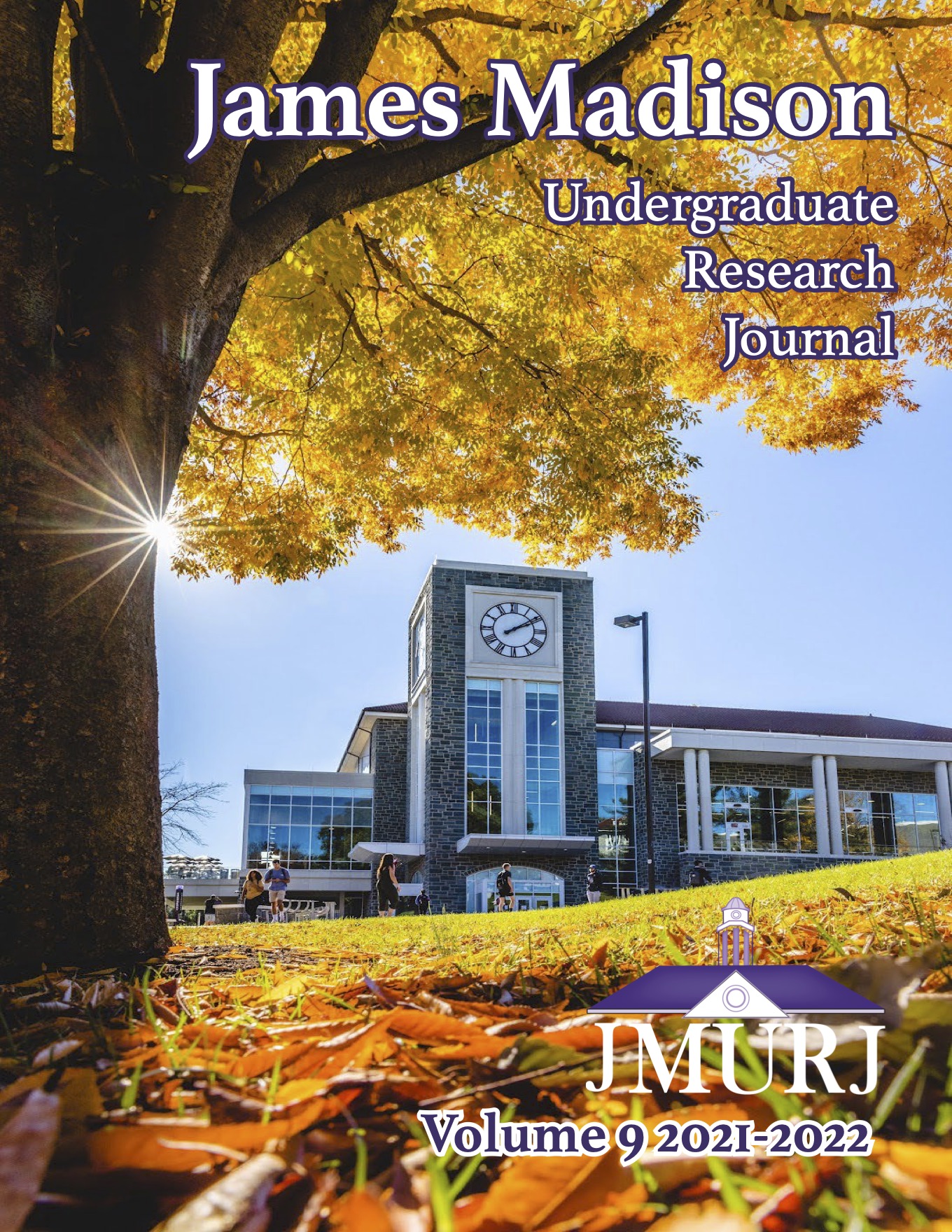

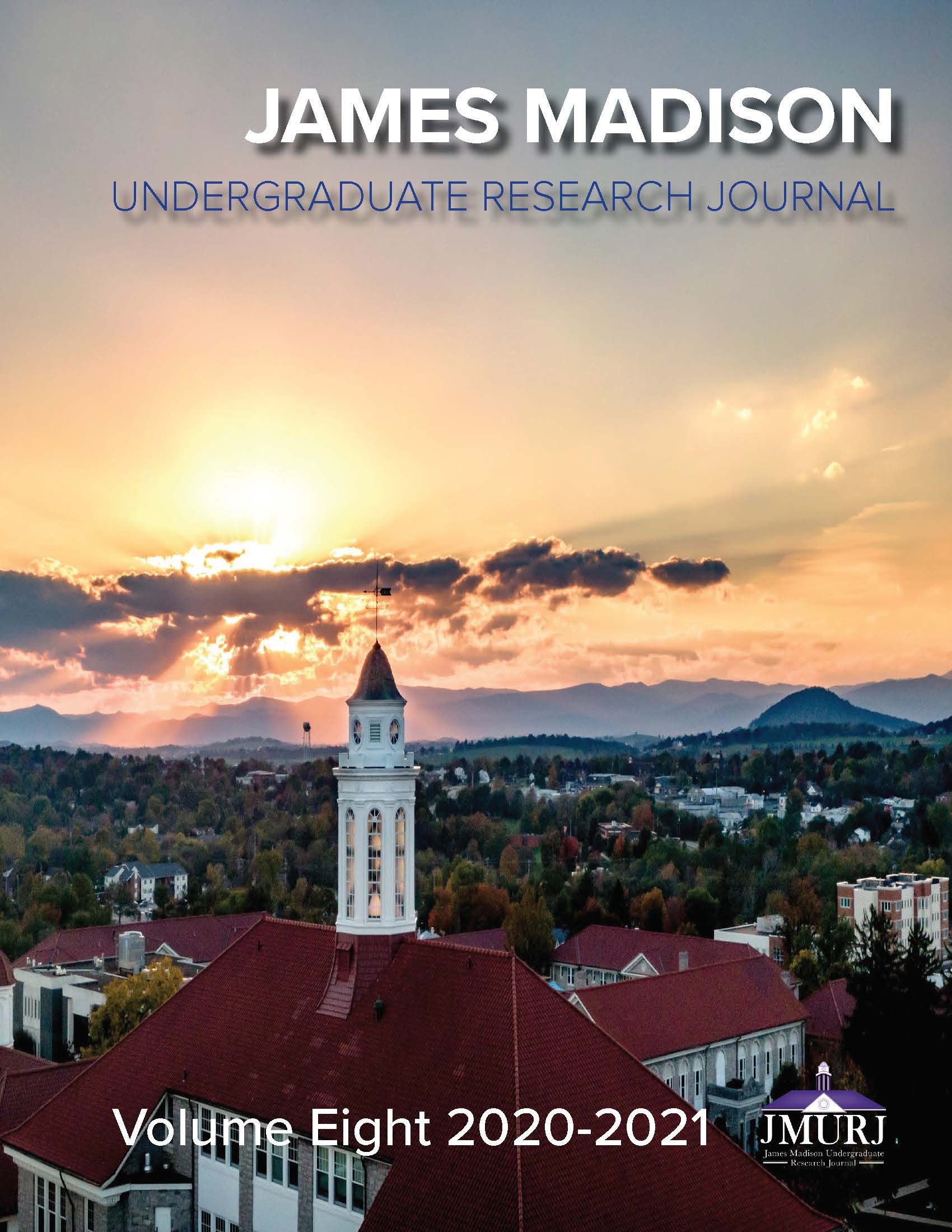
2020-2021
- Volume 8 features research and scholarship from Psychology, Music, Computer Science, Health Sciences, Intelligence Analysis, and History.
- Early in the Fall 2020 semester, after just one face-to-face meeting, the JMURJ Editorial Board goes back online for rest of the academic year. Fall 2020 Managing Editors Kim Stuart and Jennifer Switzer lead the board in completing JMURJ Volume 7 and publishing the first Volume 8 pieces.
- Three semesters into Covid-19, Spring 2021 Managing Editors Sarah Hann and Jessica Tosi step into leadership roles, coordinating the efforts of a diverse JMURJ Editorial Board that never convenes in person.
- in Fall 2021, a new incarnation of the JMURJ Editorial Board works—in person—to publish the volume's final pieces. Volume 8 Lead Designer Tori Carpenter sees the volume through from start to finish.
- The 19 first-timers among the volume's 38 faculty reviewers—from 20 different academic disciplines—mean that 233 different JMU faculty members have volunteered their time and expertise over the years.
2019-2020
- Volume 7 includes submissions from Political Science, History, International Affairs, Sociology, and Integrated Science and Technology.
- Managing Editor Logan Roddy leads a team of 16 editors pursuing 5 different majors and 13 different minors. When the Covid-19 pandemic ends face-to-face meetings in the middle of Spring 2020, the JMURJ Eeditorial Board moves its outreach, editing, and design teams online.
- A total of 45 faculty reviewers from 17 academic disciplines volunteer their time and expertise to Volume 7. Through seven volumes, JMURJ has enlisted 214 different faculty reviewers, with just over half of JMURJ's Volume 7 reviewers—23—serving for the first time.
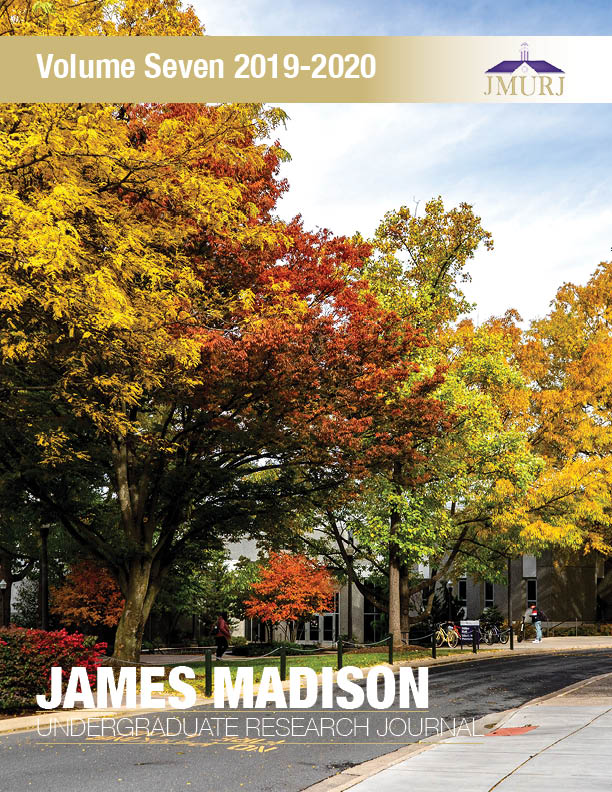
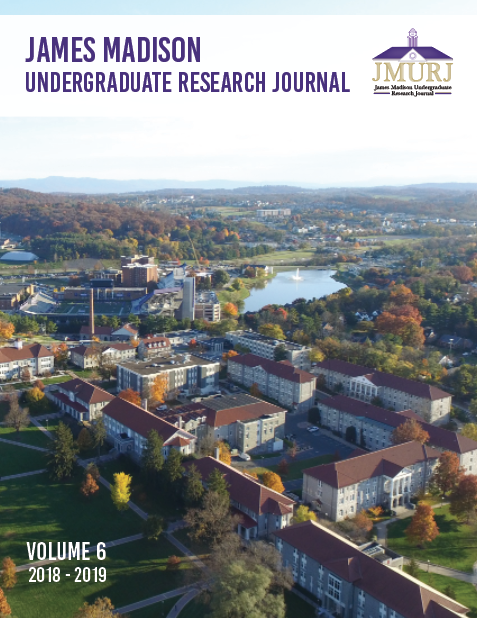
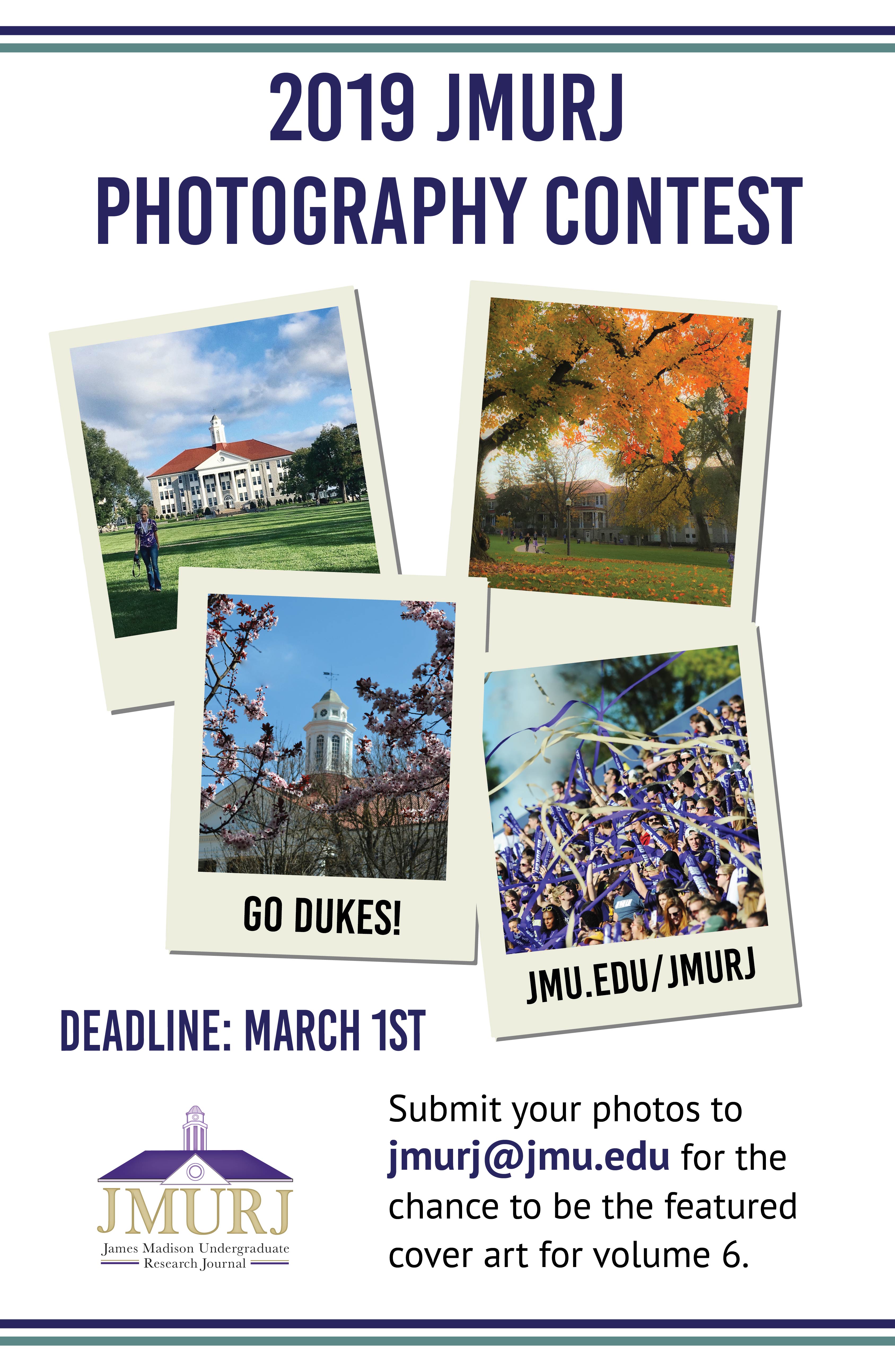
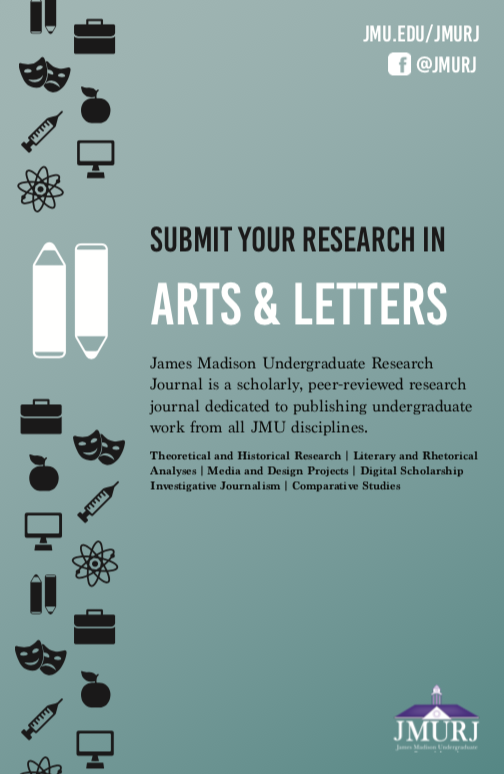
2018-2019
- Volume 6 includes submissions from Theatre Education, Biology, Psychology, Geographic Science, Political Science, Media Arts & Design / Social Justice and Photographic Media, and Social Work / Foreign Languages, Literatures, and Cultures.
- JMURJ publishes its first scholarship composed in a language other than English: Jemma Stratton's "El VPH y el cáncer cervical en el Perú: las diferencias de accesibilidad entre las mujeres de las zonas rurales y urbanas." In fact, JMURJ publishes Ms. Stratton's submission twice, adopting a landscape format to set the Spanish version alongside its English translation.
- In April 2019, JMURJ sends thank you letters to 41 Volume 6 faculty reviewers (and mugs to 18 first-timers). Through six JMURJ volumes, 191 JMU faculty members have volunteered their time and expertise as reviewers.
- The Volume 6 JMURJ Editorial Board, led by Managing Editor Matt Cappo and Head of Marketing & Design Dana Webb, features undergraduates enrolled in seven majors and ten minors.
- The JMURJ Design team creates college-specific posters and slides, a photography contest poster, and the poster below, presented at the Spring 2019 Honors Symposium.
- The JMURJ website gets a complete redesign from Dana Webb.
- The Breeze—JMU's student newspaper—publishes an article about JMURJ: "More Than a Grade."
- Congratulations to Jackson Westoff (front and back covers) and Abigail Ramsay (inside front cover), winners of the fourth annual JMURJ Cover Photo contest!
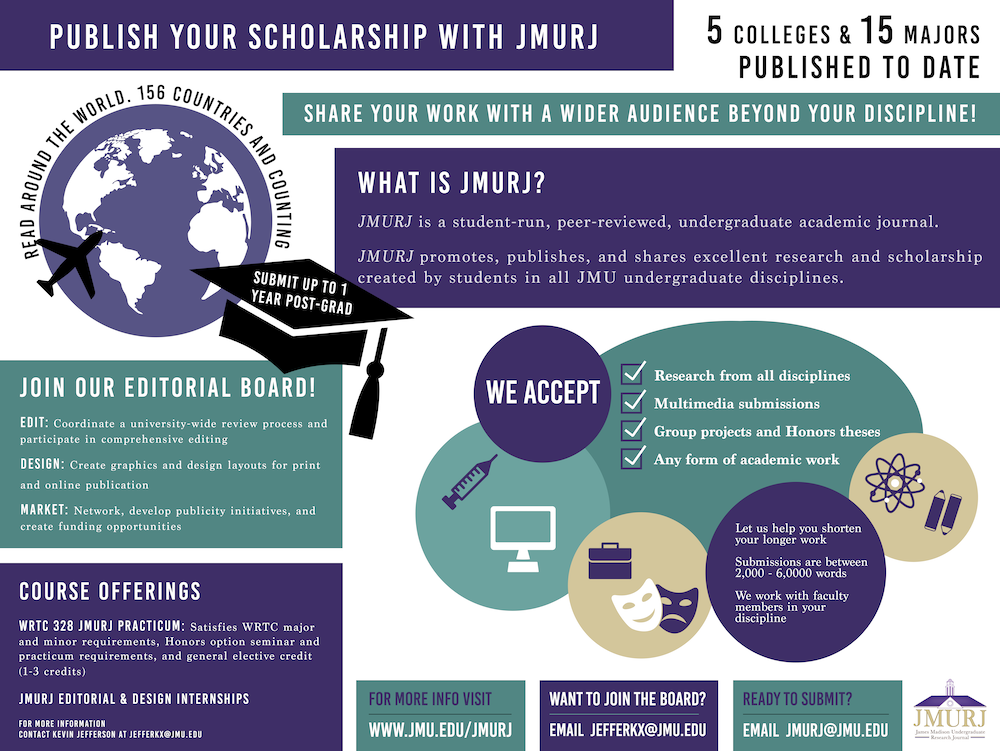
2017-2018
- Volume 5 features work from Geographic Science, Kinesiology, and Nursing—disciplines appearing for the first time in JMURJ—and from Communication Studies, History, Psychology, and Media Arts & Design. The nine pieces, including a multimedia article titled “Hackers and the Dark Net,” represent JMURJ’s largest volume so far.
- In April 2018, JMURJ sends thank you letters (and thank you mugs) to 79 Volume 5 faculty reviewers in 25 different academic disciplines. Through five JMURJ volumes, more than 175 JMU faculty members have volunteered their time and expertise as reviewers.
- A big JMURJ Editorial Board continues its residency in the Student Success Center: 23 undergraduate editors from 12 different majors and 15 different minors serve on the 2017-2018 board. Catherine Evans is the journal’s first Managing Editor; Maria Castro and Matt Cappo define the new Intern position.
- The JMURJ Design team starts from blank pages, redfining the journal's lines of new communication and reimagining the journal's layout and artwork. Plus, new stickers!
- JMURJ hits 30,000 views on its Scholarly Commons publishing platform and shifts its www.jmu.edu/jmurj site over to JMU’s Cascade Responsive design.
- In spring 2018, JMURJ sends a few precious hard copies of Volumes 1-4 to JMU leaders. JMURJ is an online journal, but it's nice every so often to hold the physical thing. Volume 5 is forthcoming in a slightly larger print run.
- JMURJ participates in JMU’s Undergraduate Research Review, collaborates with the MadRush Undergraduate Research Conference, and promotes undergraduate research and scholarship during Centennial Scholars and JMU X-Labs meetings. For the sixth year in a row, JMURJ participates in JMU’s Honors Symposium.
- Congratulations to Carrie Chang and Mary Kate Appel, winners of the third annual JMURJ Cover Photo contest.
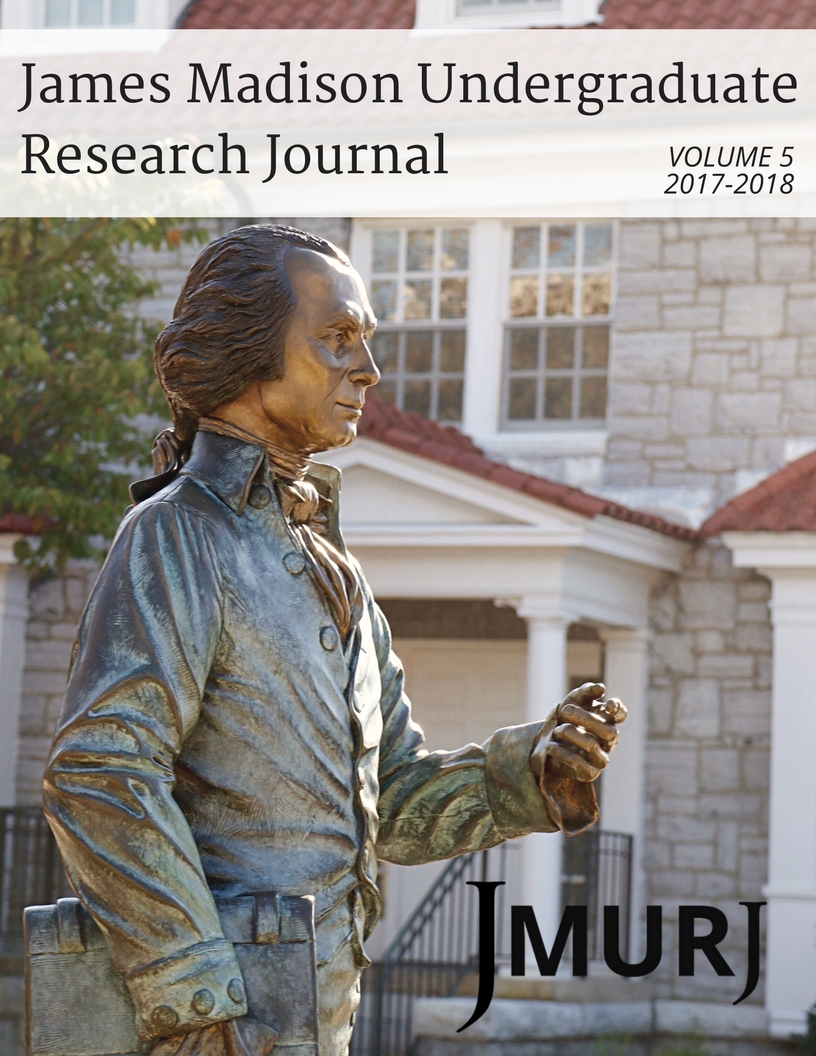
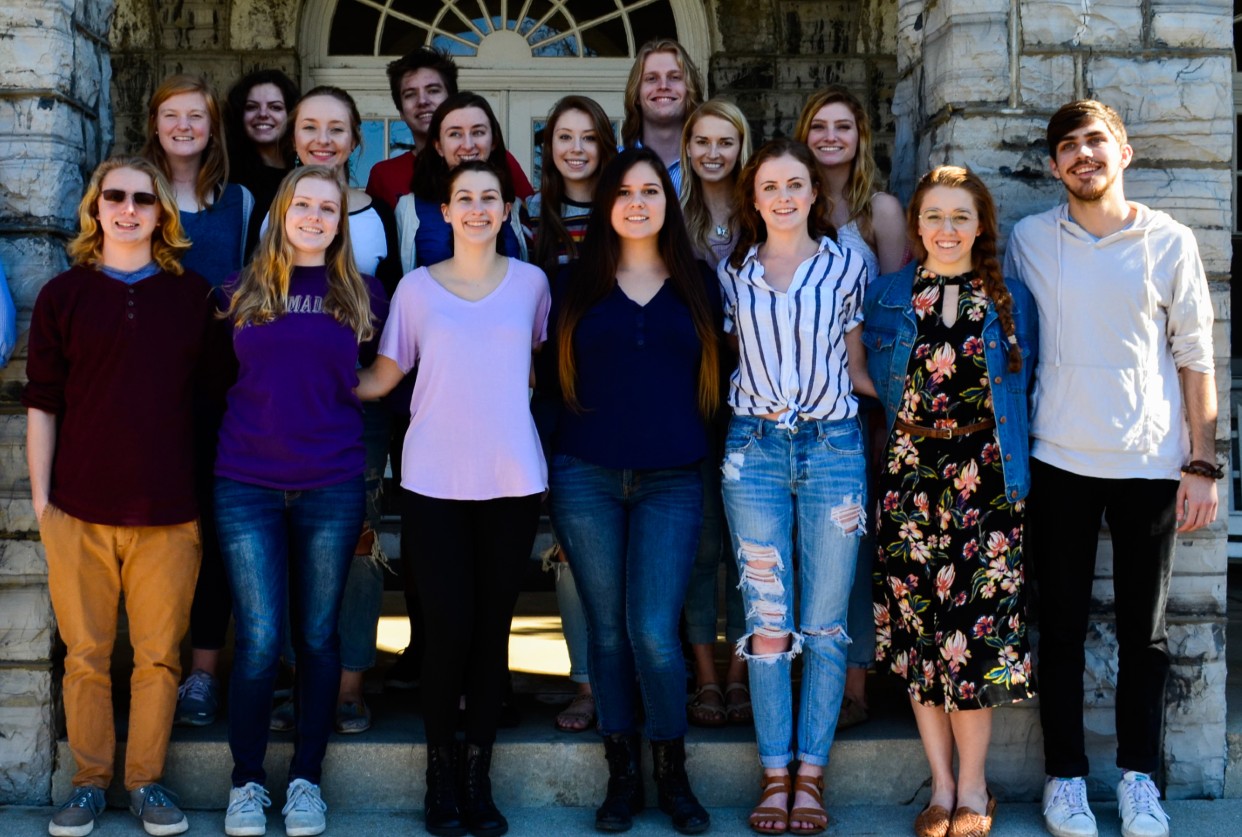
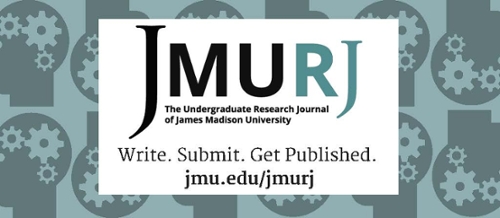
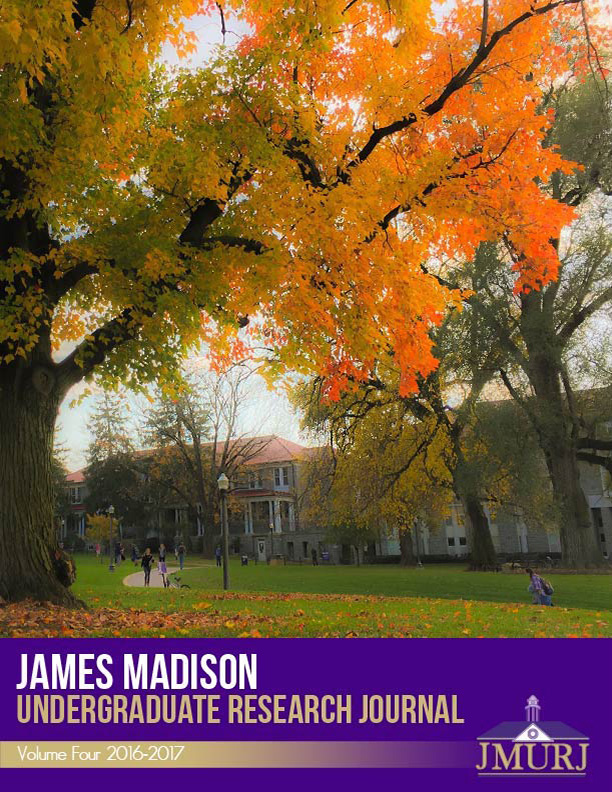

2016-2017
- Volume 4 features six submissions by five students majoring in four JMU undergraduate disciplines. Research and scholarship from undergraduates in two majors—Architectural Design and Justice Studies—appears in JMURJ for the first time.
- JMURJ celebrates its first multimedia publication by publishing it twice. The “print” version of Maya Chandler’s "Designing a Bathhouse for Charlottesville” employs a landscape format and privileges the designs and images Chandler created for her Architectural Design project over the "research statement" she wrote to accompany her JMURJ submission. Chandler's designs and images are the primary text in JMURJ's “online” Atavist version, with her research statement available to interested readers in a series of supplemental links.
- JMURJ publishes new "research statement" guidelines. The five quick questions invite JMU undergraduate researchers to supplement their media-based texts or genre-specific print texts with a brief "research statement," so that a diverse academic audience can appreciate all of the behind-the-scenes research and scholarship.
- JMURJ moves into JMU's Student Success Center; the 2016-2017 JMURJ Editorial Board features 20 returning and new undergraduate editors majoring or minoring in 24 different JMU fields of study.
- The JMURJ Design Team creates the new layout and artwork featured in Volume 4, a new JMURJ logo, featured in recent print and online publications, and a new Call for Submissions poster.
- JMURJ Editorial Board members again participate in the JMU Honors Symposium, redesigning the journal's "Publishing, Promoting, and Sharing Undergraduate Scholarship" poster as part of the effort.
- Congratulations to Christina Telep, winner of the second annual JMURJ Cover Photo contest.
2015-2016
- Volume 3 of JMURJ features six articles, including work by undergraduates majoring in Communication Studies, Psychology, Political Science, and Biology.
- JMURJ enlists its 100th faculty reviewer. Through three volumes, JMURJ has collaborated with faculty reviewers from all seven JMU colleges in more than 30 disciplines.
- JMURJ hits 9,000 downloads on its JMU Scholarly Commons publishing platform. Readers come from across the United States and around the world.
- JMURJ revisits its submission guidelines, working to expand and share its commitment to publishing text-based and media-based research and scholarship by undergraduates in all JMU disciplines.
- A panel featuring veteran JMURJ editor Lindsey Campbell presents at the Fall 2015 Virginias Collegiate Honors Council conference.
- JMURJ Editorial Board members again particpate in the JMU Honors Symposium, presenting "JMURJ: Publishing, Promoting, and Sharing Undergraduate Scholarship."
- Congratulations to Cassey Jennings, winner of the first JMURJ Cover Photo contest.
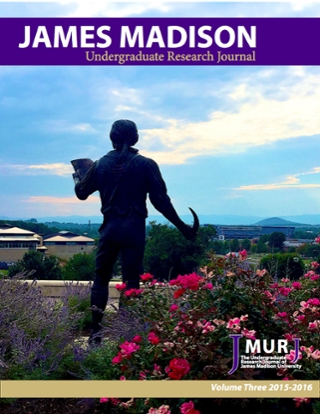
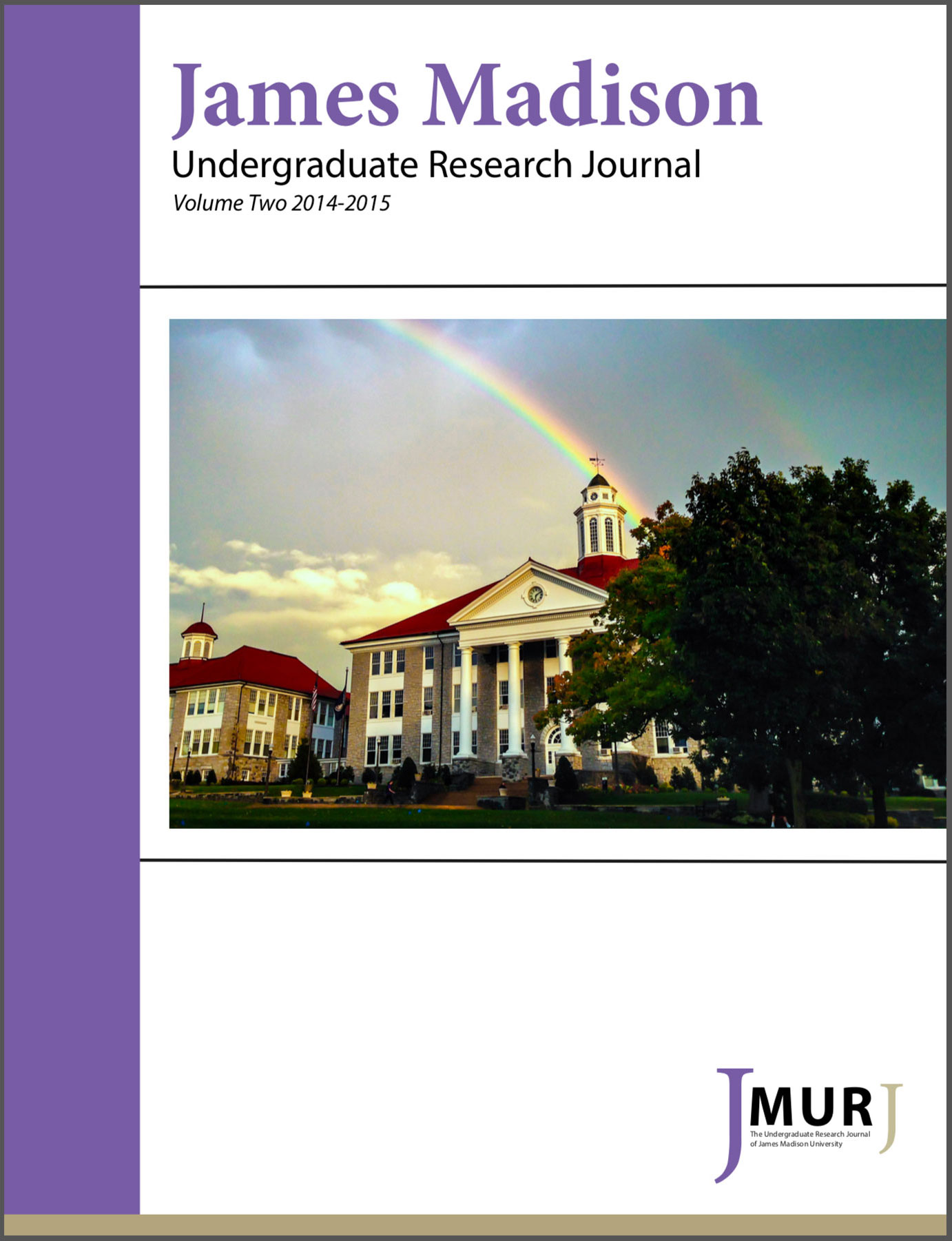
2014-2015
- JMURJ is listed on the national Council of Undergraduate Research "Undergraduate Journals" website.
- JMU alumna Juliana Garabedian (JMURJ Volume 2: "Animating Gender Roles: How Disney is Redefining the Modern Princess") is featured in an April 22, 2016, James Madison University News article titled "The evolving Disney princess: Student research receives global attention."
- JMURJ is featured in the Spring 2015 issue of the Madison Family Connection.
- JMURJ publishes its JMURJ Screening Criteria, initially an in-house document, to encourage scholarship and to share its publishing process.
2013-2014
In Spring 2013, a new JMURJ Editorial Board convenes under the auspices of the JMU Honors Program. The team invests a full year in the work of evaluating other universities' undergraduate research journals; defining JMURJ’s mission, scope, and review process; and beginning to build a corps of reviewers, sponsors, advocates, contacts, and volunteers across JMU. They build on the 2007–2009 JMURJ effort, working from two basic questions:
- How can we create a sustainable JMU undergraduate research journal?
- How can we be inclusive? How can we promote, publish, and share the different kinds of research and scholarship that JMU undergraduates do in all of their diverse academic fields of study?
Three semesters in, the Spring 2014 JMURJ Editorial Board has good news to share:
- JMURJ publishes its first new issue in five years.
- JMU’s Office of Research and Scholarship signs on as an early JMURJ sponsor.
- JMU faculty in disciplines across campus volunteer to serve on the JMURJ Faculty Review Board.
- JMURJ begins its collaboration with Digital Collections Librarian Laura Drake Davis as JMU Libraries develops JMU's new Scholarly Commons publishing platform.
- JMURJ is featured in a February 2014 JMU website article titled “Students re-establish undergraduate research journal.”
- JMU President Jonathan Alger recognizes JMURJ as one of JMU's recent "Academic Accomplishments" in his February 2014 "Faculty and Staff Email Update."
- JMURJ editors present at JMU's annual Honors Symposium in both 2013 and 2014.
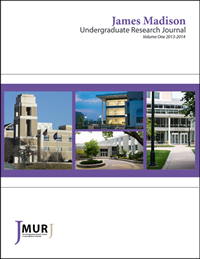
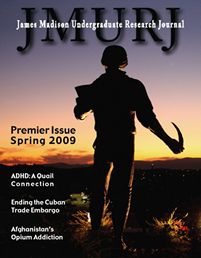
2007-2009
JMU undergraduate Physics majors Casey Boutwell and Laurence Lewis founded the James Madison Undergraduate Research Journal in 2007, envisioning a JMU undergraduate journal that could foster "a community of ambitious, open-minded student-researchers" by encouraging the multidisciplinary collaboration, peer review, and publication opportunities that are at the heart of professional academia.
They visited classes, talked to professors, enlisted Dr. Kurt Schick, then the Director of the University Writing Center, as a faculty adviser, and spent the next year defining the journal and establishing a campus presence.
The blueprint Boutwell and Lewis developed for JMURJ was "simple and easily reproducible":
We developed a preliminary model of how we imagined an undergraduate research journal would operate. We determined which features were important to us (like multiple disciplines, student administration, and peer review), and what characteristics we wanted to avoid (too much university oversight and overly constraining our definition of research).
In Spring 2009, a team of editors led by Sierra Stanczyk and Alex Sharp VIII published the first issue of JMURJ.
1994-1997
JMU's College of Letters and Sciences published four volumes of the Madison Journal of Undergraduate Research between 1994 and 1997. Student editors participating in two 300-level English classes published "research manuscripts written by JMU undergraduates from all disciplines within the university" with a goal of promoting "the importance of researching and writing throughout academia and the professions."
Print volumes of MJUR are available in the JMU Libraries Special Collections Reading Room. We offer the first pages of Volume 1 and the preface from Volume 2 here.
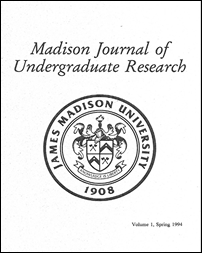
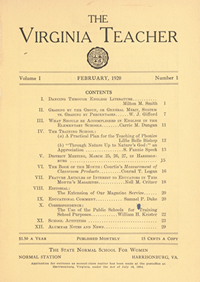
1920-1939
The Virginia Teacher, also available in the JMU Libraries Special Collections Reading Room, was one of JMU’s regular early publications (along with The Breeze and The Normal Bulletin). While early volumes featured articles by faculty members from the State Normal School for Women at Harrisonburg (1914–1924) and the State Teachers College at Harrisonburg (1924–1938), as well as by local school teachers, the journal increasingly included scholarship by professors at other state and regional colleges.
The Virginia Teacher also regularly published student articles throughout its twenty-year run. Nell M. Critzer's review titled “Feature Articles of Interest to Educators in this Month’s Magazines” appeared in Volume 1, Issue 1 (1920). Critzer—author of several Virginia Teacher pieces—mentions a fellow by the name of Albert Einstein, who was apparently doing some good work. Her piece in Issue 1 of The Virginia Teacher appears just before an "Educational Comment" from Samuel Page Duke (still in the first of his thirty years as the school's second president).
Clare Harnsberger, "awarded the Dingledine Prize for the best essay submitted by this year’s graduating class," was also published in The Viriginia Teacher in 1920. Harnsberger was the second of many Dingledine scholarship recipients, as Raymond Carlyle Dingledine, Sr., and Agness Dingledine began awarding a $10 prize for the best senior essay in 1919. Harnsberger's essay, titled “Sonnet Forms,” appeared in Volume 1, Issue 6 of The Virginia Teacher.
